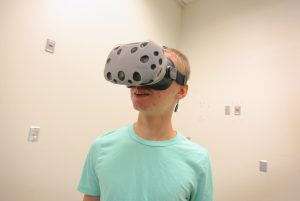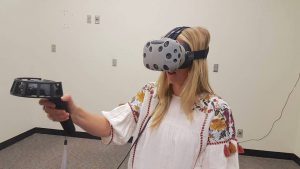By Lydia Hansen
Editor-in-Chief
Lydia.Hansen1961@mb.rctc.edu
Thanks to a grant from Minnesota State, virtual reality technology has become a reality for RCTC’s Earth Science department.
Combined funding from RCTC as well as a Minnesota State grant has provided for the purchase of three sets of virtual reality goggles, including the corresponding software and computers necessary to set up three virtual reality labs on campus.
“What we’ll be using is the HTTC Vive, which is one of the kinds of goggles you can use for virtual reality,” said Dr. John Tacinelli, an RCTC faculty since 1997 who teaches in the Earth Science department.
He explained that the goggles, which connect to a large computing system with a cord, can run virtual reality apps that allow students to experience concepts of Astronomy and Geology classes in a whole new way. Sensors in the goggles, mounted on the walls, and in hand-held controllers, track movement to coordinate the simulation in the goggles, allowing wearers to move about within the reality experience.
Tacinelli’s Astronomy class tested the labs, using a program called “Titans of Space” to render the solar system to scale and in 3D, something difficult to visualize through traditional means.
“You can use the controllers to select planets and put them together to compare the size, and you can even pick up’ a planet to look at it from all sides,” Tacinelli said of how the program operates.

Photo courtesy of Ken Klotzbach, Rochester Post Bulletin
Jack Rubio looks into our solar system with the help of the school’s new virtual reality equipment.
He plans to add virtual reality to his Principles of Geoscience class, using Google Earth’s virtual reality program, which allows users to travel to any place on Earth and see it in 3D.
“You can go to the Matterhorn glacier and look at ice or visit volcanoes or even your house,” Tacinelli said. “You’re like Godzilla striding across the world.”
There are also plans to purchase similar programs for Anatomy and Physiology classes, which will open the virtual reality labs to even more students in the future. However, Tacinelli sees a few speed bumps ahead in making the best use of the virtual reality labs.
“The challenge is how do you turn that into something you can do for credit, that you can do for a grade. How do you bring that to the students?”
Tacinelli offered sessions of lab time for his students on Student Success Day in September as extra credit but said that “I had more students who wanted to do it who couldn’t because of time and space constraints.”

Another student takes the virtual reality programs for a spin, using the hand-held controllers to manipulate the objects within the simulation.
While that problem will be partially solved when the other two labs are set up and equipped with computers, there will still be limitations because of the number of goggles available.
“We might eventually get 4-5 more, but we won’t be able to get 24 for a whole class,” Tacinelli said. Although the cost of the technology has dropped rapidly in recent years, it cost over $20,000 to fund the project and purchase the necessary equipment.
Other foreseeable complications include combining virtual reality with the D2L Brightspace system for homework assignments, since both programs can’t be open at once. This may mean virtual reality lab assignments would be group projects, where students take turns wearing the goggles and reading instructions.
“We’re at the bleeding edge of technology here,” Tacinelli said of the new systems. “Lots of experimentation will be needed to make it work best. We’re just at the beginning Ò we haven’t had a chance to experience all the options.”
Access to this kind of technology in the first place, he said, is all due to RCTC staff member Guy Hamernik, who works in the Educational Technology department and the Technology Support Center. Hamernik not only came up with the idea for the virtual reality labs, but also created a budget for the project and recruited faculty members and administration help to pitch the idea to a Minnesota State reviewing panel for a grant to help design innovative classroom spaces.
“I think they (the panel) were very impressed with what we had, as well as the level of buy-in from administration,” Tacinelli reported, adding that despite having little time to rehearse, everything went perfectly.
“It must have been hard to follow us because we did such an awesome job,” he said. “And it’s all due to Guy Hamernik because he’s the one who really pushed it.”
